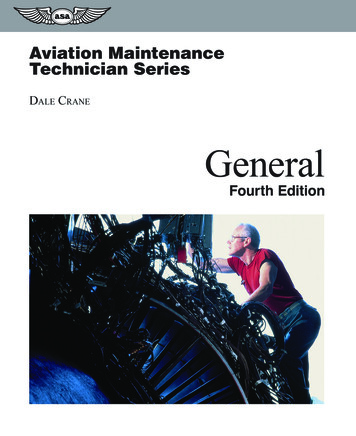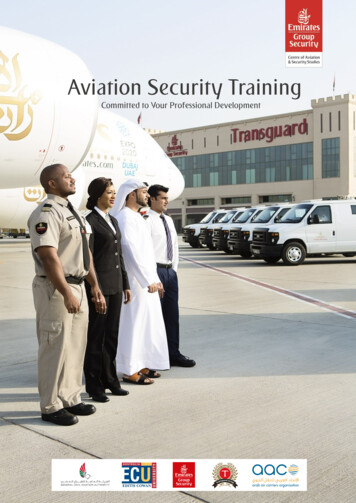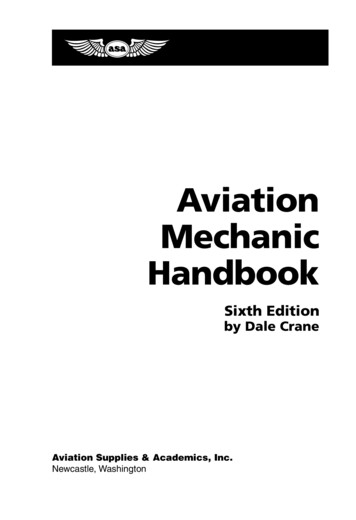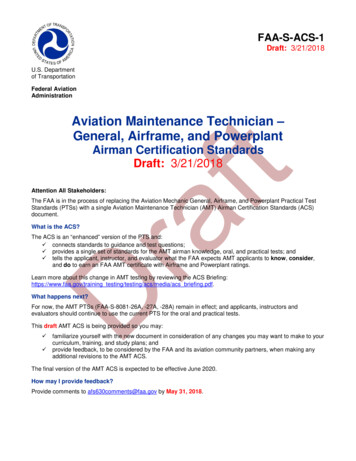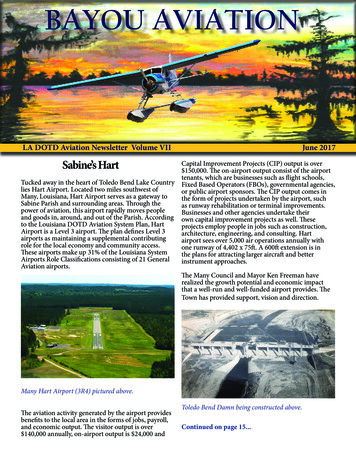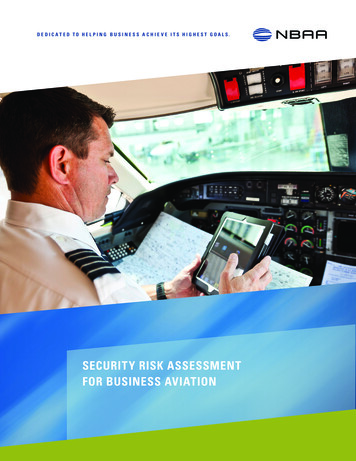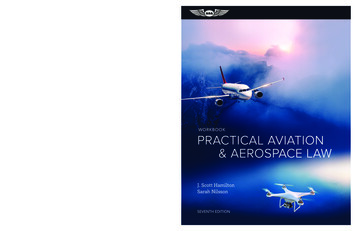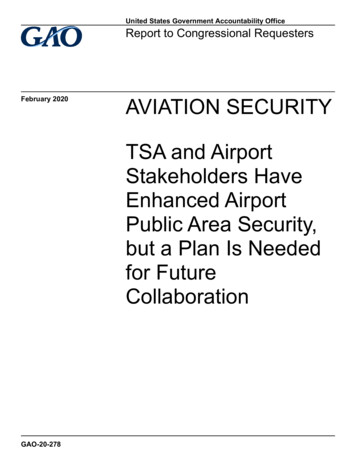
Transcription
United States Government Accountability OfficeReport to Congressional RequestersFebruary 2020AVIATION SECURITYTSA and AirportStakeholders HaveEnhanced AirportPublic Area Security,but a Plan Is Neededfor FutureCollaborationGAO-20-278
February 2020AVIATION SECURITYHighlights of GAO-20-278, a report tocongressional requestersTSA and Airport Stakeholders Have Enhanced AirportPublic Area Security, but a Plan Is Needed for FutureCollaborationWhy GAO Did This StudyWhat GAO FoundThreats to public areas of airports haveincreased in recent years. TSA isresponsible for civil aviation security,which includes ensuring the securityand safety of aircraft and the travelingpublic. In November 2013, an armedindividual entered the Los AngelesInternational Airport (LAX) and killed aTransportation Security Officer.Subsequent domestic and internationalattacks in airport public areas furtheremphasized the need to better securethese areas. In response, Congresshas taken action—including passage ofthe 2015 Gerardo Hernandez Act andthe 2018 TSA Modernization Act—toaddress incident planning andresponse at airports and the security ofpublic areas of transportation facilities,including airports.The Transportation Security Administration (TSA) took several actions inresponse to the 2013 Los Angeles International Airport (LAX) shooting and theGerardo Hernandez Airport Security Act of 2015. Specifically, TSA took severalactions to better address airport security in public areas, including strengtheningand mandating active shooter training drills and installing duress alarms atscreening checkpoints, among other things. In response to the Act, TSA updatedguidance for reporting suspicious behavior and revised directives identifyingresponsibilities for local law enforcement coverage of passenger screeningcheckpoints and nearby public areas, among other actions.GAO was asked to assess actionstaken to secure the public areas ofTSA- regulated airports. This report (1)describes actions TSA has taken inresponse to the LAX shooting and theGerardo Hernandez Act, and (2)examines additional actions taken inresponse to subsequent securityincidents and the TSA ModernizationAct.GAO reviewed TSA reports issuedafter airport attacks; the GerardoHernandez Act and TSA ModernizationAct; and other TSA documents relatedto securing public areas. GAO alsoconducted interviews with andobtained information from TSA andofficials from a nongeneralizablesample of 6 TSA-regulated airports,selected based on factors such as sizeand location.In response to subsequent airport public area security incidents, such as those inFort Lauderdale in 2017 and Brussels and Istanbul in 2016, TSA has takenadditional actions. Specifically, TSA issued the Public Area Security NationalFramework in 2017, in coordination with various aviation security stakeholders.The framework categorized 11 best practices and non-binding recommendationsfor improving security of public areas, including sharing information andpreventing attacks. Aviation security stakeholders have also implementedvarious actions consistent with these best practices, including establishing airportoperations centers and deploying enhanced law enforcement teams to serve asa visible deterrent in airport public areas (see figure). In response to the TSAModernization Act, TSA established a public area security working group inMarch 2019 to engage with stakeholders such as airport operators and industryassociations and update and validate the best practices cited in the 2017framework. This group met twice in 2019, but TSA has not outlined specific plansfor engaging this group in the future. Developing a plan outlining the roles andresponsibilities of the working group members, the mechanisms through whichthe working group will collaborate, and the frequency of when the working groupwill meet, would better position TSA to ensure the best practices cited bystakeholders remain relevant and emerging threats are proactively identified.Enhanced Law Enforcement Teams Patrol Public Areas at the Los Angeles InternationalAirport to Provide a Visible DeterrentWhat GAO RecommendsGAO recommends that TSA develop aplan for future stakeholderengagement on the security of airportpublic areas. DHS concurred with therecommendation.View GAO-20-278. For more information,contact William Russell at (202) 512-8777 orRussellW@gao.govUnited States Government Accountability Office
ContentsLetter1BackgroundTSA Took Various Actions to Enhance Public Area Security inResponse to the 2013 LAX Shooting and Gerardo HernandezActTSA and Stakeholders Took Additional Actions to Enhance AirportPublic Area Security, but TSA Does Not Have a Plan for FutureStakeholder CollaborationConclusionsRecommendation for Executive ActionAgency Comments and Our Evaluation71723383939Appendix IComments from the U.S. Department of Homeland Security41Appendix IIGAO Contact and Staff Acknowledgments44FiguresFigure 1: Illustration of Public and Security-Restricted Areas at aCommercial Airport in the United StatesFigure 2: Timeline of Attacks in Airport Public Areas, and Actionsto Address the Security of Airport Public AreasFigure 3: Examples of Transportation Security AdministrationDuress Alarms Installed at Passenger ScreeningCheckpointsFigure 4: Timeline of Airport Public Area Security Summits andActivities from September 2016 through May 2017Figure 5: Best Practices Outlined in the Transportation SecurityAdministration’s 2017 Public Area Security NationalFrameworkFigure 6: Los Angeles International Airport ResponseCoordination Center and Incident Management CenterProvides Real-Time Coverage of Airport Security-RelatedIncidents and Flight OperationsFigure 7: Enhanced Law Enforcement Teams Conduct Patrolsaround Ticketing Counter Areas to Provide a VisibleDeterrent at Los Angeles International Airport, November2018Page i9161824253135GAO-20-278 TSA Security of Airport Public Areas
Figure 8: Law Enforcement Teams Conduct Patrols of the Atriumwithin the Public Area to Provide a Visible Deterrent froman Elevated Location at Atlanta-Hartsfield InternationalAirport, March 2019Figure 9: Broward County Sheriff’s Office Explosives DetectionCanine during Training Exercise Conducted in theBaggage Claim Area of Fort Lauderdale-HollywoodInternational Airport, February 2019Figure 10: Illustration of Shooter Detection System Similar toCharleston International AirportPage ii363738GAO-20-278 TSA Security of Airport Public Areas
nt Federal Security Director for InspectionsAirport Security ProgramAviation and Transportation Security ActBroward County Aviation DepartmentClosed Circuit TelevisionCybersecurity and Infrastructure Security AgencyDepartment of Homeland SecurityFederal Aviation AdministrationFederal Bureau of InvestigationFederal Security DirectorIncident Command SystemIntermodal Security Training and Exercise ProgramJoint Vulnerability AssessmentLaw Enforcement/Federal Air Marshal ServiceNational Terrorism Advisory SystemPolicy, Plans, and EngagementScreening Partnership ProgramTransportation Security AdministrationTransportation Security OfficerTransportation Security Operations CenterVisible Intermodal Prevention and ResponseThis is a work of the U.S. government and is not subject to copyright protection in theUnited States. The published product may be reproduced and distributed in its entiretywithout further permission from GAO. However, because this work may containcopyrighted images or other material, permission from the copyright holder may benecessary if you wish to reproduce this material separately.Page iiiGAO-20-278 TSA Security of Airport Public Areas
Letter441 G St. N.W.Washington, DC 20548February 11, 2020The Honorable Bennie G. ThompsonChairmanCommittee on Homeland SecurityHouse of RepresentativesThe Honorable John KatkoHouse of RepresentativesThe Honorable Michael T. McCaulHouse of RepresentativesThe Honorable Bonnie Watson ColemanHouse of RepresentativesAttacks in the public areas of airports in recent years have sparkedconcern about threats facing these open access high-traffic areas. Ingeneral, the public area of an airport includes any space on airportproperty (such as ticketing areas, baggage claims, restaurants and transithubs) to which the general public may have free and unrestricted accesswithout being subjected to the screening or other security measures thatwould permit them entry into a particular area of the airport or to board anaircraft. These locations have been attractive targets for an attackbecause large clusters of people may gather in these public areas duringpeak travel times. For example, In November 2013, an armed individualentered the Los Angeles International Airport (LAX) and fired multipleshots while in the public area, killing a Transportation Security Officer(TSO) and injuring two other TSOs and a passenger. 1 This event markedthe first time an employee of the Transportation Security Administration(TSA) was killed in the line of duty since the agency was established1 Transportation Security Officers (TSOs) are TSA employees who conduct securityscreening of passengers, accessible property and checked baggage at TSA-regulatedairports to prevent the unauthorized carriage of deadly or dangerous objects (i.e.,prohibited items) beyond security checkpoints and onto aircraft.Page 1GAO-20-278 TSA Security of Airport Public Areas
following the terrorist attacks of September 11, 2001. 2 In January 2017, agunman opened fire and killed five people inside the baggage claim areaof the Fort Lauderdale-Hollywood International Airport (FLL). Morerecently, in September 2019, a man fired a gun in the baggage claim areaof the Portland International Airport (PDX). Also, attacks at foreignairports in March 2016, when bombs were detonated in the departureshall of Brussels International Airport’s main terminal prior to the securitycheckpoint, and in June 2016 when gunmen opened fire and detonatedsuicide vests in the arrivals hall, departures hall, and parking lot atIstanbul Ataturk Airport, highlight the evolving tactics used to harm peoplein airport public areas.Enacted in September 2015, the Gerardo Hernandez Airport Security Actof 2015—named for the deceased TSO from the LAX shooting—directedTSA to, among other things, take actions to address incident response atairports. 3 Specifically, the act directed TSA to verify that TSA-regulated(i.e., commercial) airports have plans in place to respond to securityincidents including those involving active shooters, acts of terrorism, andincidents that target passenger screening checkpoints. In addition, thisact directed TSA to provide annual certification to Congress thatscreening personnel have participated in practical training exercises foractive shooter scenarios. The act also directed TSA to identify bestpractices that exist across airports for security incident planning,management and training, and establish a mechanism to share suchpractices with airport operators. 4 The TSA Modernization Act, enacted in2018, directed TSA, among other things, to establish a Public AreaSecurity Working Group in coordination with the National Protection andPrograms Directorate (since re-designated the Cybersecurity andInfrastructure Security Agency) to promote collaborative engagement2Pursuant to the Aviation and Transportation Security Act (ATSA), which was signed intolaw shortly after the terrorist attacks of September 11, 2001, TSA assumed responsibilityfor security in all modes of transportation, which includes implementing and overseeingsecurity operations with the U.S. civil aviation system. See Pub. L. No. 107-71, 115 Stat.597 (2001). In general, civil aviation includes all nonmilitary aviation operations, includingscheduled and chartered air carrier operations, cargo operations, and general aviation, aswell as the airports servicing these operations.3See Pub. L. No. 114-50, 129 Stat. 490 (2015). For the purposes of this report “theGerardo Hernandez Act” is used as an abbreviated version of the Gerardo HernandezAirport Security Act of 2015.4 The Gerardo Hernandez Act also required TSA to report to Congress on findings from itsoutreach to airports; including an analysis of the level of preparedness such airports haveto respond to security incidents. See Pub. L. No. 114-50, § 3(c), 129 Stat. at 491.Page 2GAO-20-278 TSA Security of Airport Public Areas
between TSA and public and private stakeholders. 5 This act also directedTSA to periodically submit information on best practices for protectingpublic spaces of transportation infrastructure from emerging threats toappropriate transportation security stakeholders. 6Although TSA’s statutory authorities and responsibilities for civil aviationare broad, resource and other practical constraints, as well as TSA’smission to secure civil aviation without unduly impeding the flow ofcommerce, have resulted in a regulatory structure largely focused onimplementing measures that ensure the security of the aircraft and thetraveling public. For example, while TSA exercises more directoperational control over certain aspects of security, such as the screeningof passengers and property, it generally has no operational role insecuring airport public areas and works collaboratively with airportoperators and other stakeholders to respond to any security incidents.Subject to TSA oversight, regulated entities—such as airport and aircraftoperators—implement access control measures and, in conjunction withstate or local law enforcement agencies, must be capable of respondingto an incident at their airport—whether in an airport public area or withinan area for which access is controlled (i.e. a security-restricted area).You asked us to review actions TSA has taken to secure the public areasof commercial airports. This report (1) describes actions TSA has taken toenhance the safety and security of screening personnel and the securityof airport public areas in response to the 2013 LAX shooting and theGerardo Hernandez Act, and (2) examines additional actions TSA andaviation security stakeholders have taken in response to subsequentsecurity incidents and the TSA Modernization Act.To describe the actions taken by TSA in response to the LAX shootingand Gerardo Hernandez Act, we reviewed TSA’s 2014 report, “EnhancingTSA Officer Safety and Security: Agency Actions and Path Forward,”which summarized findings from TSA’s internal review of its policies,procedures and training to identify possible improvements to safety andsecurity for TSA employees. We reviewed requirements included in theGerardo Hernandez Act, and other TSA security requirements relevant to5See Pub. L. No. 115-254, div. K, tit. I, §§ 1931-1932, 132 Stat. 3186, 3569-72 (2018).The TSA Modernization Act was enacted as division K, title I of the FAA ReauthorizationAct of 2018 on October 5, 2018.6See id. §§ 1931(c)(2), 1932(a), 132 Stat. at 3570, 3571.Page 3GAO-20-278 TSA Security of Airport Public Areas
security in airport public areas, including mandates and directives forrevised active shooter training for employees and regular testing ofduress alarms, in addition to standards and amendments for lawenforcement presence at airport security checkpoints. We also reviewedrevised active shooter training videos, and a data sample depictingweekly duress alarm testing from TSA’s performance managementinformation system. We observed security operations and demonstrationsof law enforcement presence at security checkpoints and in airport publicareas from airport site visits. We also reviewed TSA’s report submitted toCongress to address requirements of the Gerardo Hernandez SecurityAct. 7 Further, we interviewed TSA and airport officials located at LAX toobtain additional information on the incident, and the subsequent reviewsand report identifying potential improvements to the safety and security ofTSOs and security of the airport public area. 8To evaluate actions TSA and aviation security stakeholders, includingairport and law enforcement officials, have taken in response to othersecurity incidents and the TSA Modernization Act, we analyzeddocuments related to securing public areas including the “FortLauderdale-Hollywood International Airport Active Shooter Incident andPost Event Response, January 6, 2017 After-Action Report”, and the“2017 Public Area Security National Framework”. In addition, we analyzedTSA security directives and information circulars addressing public areasof airports, joint vulnerability assessments (JVAs), and JVA MitigationAction Plans for selected airports. 9 Further, to assess actions TSA has7Department of Homeland Security, Transportation Security Administration, GerardoHernandez Airport Security Act of 2015 Interoperability Review (April 19, 2016). Inaddition, TSA submitted information in March 2016 that addressed Security IncidentResponse at Airports and Incident Response for Transportation Systems, and submittedan Interoperability Review and Letter to Congress on the Impact of the Law EnforcementReimbursement Program in April 2016.8Unless otherwise stated, references to Transportation Security Officers (TSOs) includescreening personnel employed by companies contracting with TSA to provide screeningservices at airports participating in TSA’s Screening Partnership Program. See 49 U.S.C.§ 44920.9Joint Vulnerability Assessments (JVAs) are assessments that teams of TSA specialagents and other officials conduct jointly with the Federal Bureau of Investigation (FBI)and, as required by law, are generally conducted every 3 years for airports identified ashigh risk. See 49 U.S.C. § 44904; Pub. L. No. 104-264, § 310, 110 Stat. 3213, 3253(1996). Federal security directors (FSD) are responsible for developing a mitigation actionplan that identifies specific steps to correct the vulnerabilities identified in the JVA Report,and submit the completed action plan to their respective Regional Director and the LawEnforcement/Federal Air Marshals Security Assessments Section.Page 4GAO-20-278 TSA Security of Airport Public Areas
put in place to enhance the security of airport public areas in response torequirements of the TSA Modernization Act addressing public areassecurity across transportation systems, we analyzed the October 2019document “Protecting Public Areas - Best Practices andRecommendations.” 10 We also interviewed TSA Policy, Plans, andEngagement officials and Department of Homeland Security (DHS)Cybersecurity and Infrastructure Security Agency (CISA) officials todetermine what progress has been made in creating a Public AreaSecurity Working Group and sharing best practices with other aviationand surface transportation mode security stakeholders. We comparedinformation collected through our review of the October 2019 bestpractices and recommendations document and interviews with agencyofficials with a provision in the TSA Modernization Act for TSA toperiodically share best practices for protecting transportation public areas,our prior work on leading practices on collaborative mechanisms relatedto establishing clear goals and identifying roles and responsibilities, andstandards for project management related to developing a plan and timeframes. 11To address both objectives, we also interviewed TSA headquartersofficials from offices including Law Enforcement/Federal Air MarshalsService; Policy, Plans and Engagement; Requirements and CapabilitiesAnalysis; Security Operations; Strategy, Policy Coordination andInnovation; and Training and Development. Specifically, we interviewedthese officials to obtain information on security requirements related topublic areas of airports, the status of actions taken after the LAX incident,additional actions taken to address the best practice recommendationidentified in the Public Area Security National Framework, and efforts ofthe working group to update recommendations to improve security inpublic areas of transportation facilities, consistent with the TSAModernization Act.10 Transportation Security Administration, Protecting Public Areas: Best Practices andRecommendations (Arlington, VA: October 2019).11GAO, Results-Oriented Government: Practices That Can Help Enhance and SustainCollaboration among Federal Agencies, GAO-06-15 (Washington, D.C.: Oct. 21, 2005);GAO, Managing for Results: Key Considerations for Implementing InteragencyCollaborative Mechanisms, GAO-12-1022 (Washington, D.C.: Sept. 2012); ProjectManagement Institute, Inc., A Guide to the Project Management Body of Knowledge(PMBOK Guide), Sixth Edition, 2017. PMBOK is a trademark of Project ManagementInstitute, Inc.Page 5GAO-20-278 TSA Security of Airport Public Areas
We also conducted site visits of six commercial airports from October2018 to June 2019. 12 During these visits we observed airport securityoperations and discussed security activities and actions taken to enhancethe safety and security of TSOs and the security of public areas of theairports with airport officials, law enforcement officials, TSA federalsecurity directors (FSD) or their representatives, and TSO’s. 13 During oursite visits, we also held group discussions with TSOs, and separately,TSO supervisors to discuss any specific concerns they had regardingtheir safety since the LAX incident and other attacks. 14 In addition, weinterviewed, by phone, airport officials from one additional airport,Charleston International Airport in South Carolina, to discuss newtechnologies designed to enhance public area security. The results ofthese site visits and interviews cannot be projected to all of theapproximately 430 commercial airports in the United States. However,these site visits and interviews provided us with on-site TSA and airportofficials’ perspectives on actions taken that were intended to strengthenthe security of airport public areas. Further, we interviewed officials fromfour industry associations based on their participation in security summitsto collaborate in identifying practices to enhance airport public area12 We conducted site visits at the following airports: Fort Lauderdale-HollywoodInternational Airport, Hartsfield-Jackson Atlanta International Airport, Los AngelesInternational Airport, Orlando International Airport, Orlando Sanford International Airport,and Ronald Reagan Washington National Airport. We selected these airports for site visitsand interviews based on a variety of factors, including airports that have experienced amajor security incident in their public areas during the last 5 years; larger (Category X andI) airports with high passenger volume; airports that participate in TSA’s ScreeningPartnership Program (SPP); airports that have recently implemented new technology orinfrastructure enhancements related to securing public areas; and the airport’s location toprovide a diverse geographic representation of airports. TSA classifies the nation’sapproximately 430 commercial airports into one of five categories (X, I, II, III, and IV)based on various factors, such as the number of take-offs and landings annually, theextent of passenger screening at the airport, and other security considerations. In general,category X airports have the largest number of passenger boardings and category IVairports have the smallest.13 FSDs are the ranking TSA authorities responsible for leading and coordinating TSAsecurity activities at the nation’s approximately 430 commercial airports.14We met with approximately 50 TSOs and TSO supervisors with 7 months to 17 years ofexperience to obtain their perspectives on TSO safety and security. The individualsparticipating in the group discussions were selected by TSA officials at the airport basedon their availability and various levels of job experience.Page 6GAO-20-278 TSA Security of Airport Public Areas
security, and because of these associations’ specialized knowledge andexperience with airport security operations. 15We conducted this performance audit from July 2018 through February2020 in accordance with generally accepted government auditingstandards. Those standards require that we plan and perform the audit toobtain sufficient, appropriate evidence to provide a reasonable basis forour findings and conclusions based on our audit objectives. We believethat the evidence obtained provides a reasonable basis for our findingsand conclusions based on our audit objectives.BackgroundAirport Public AreasCommercial airports in the United States (i.e., those regulated by TSA)can be generally described as having security-restricted areas andunsecured areas. 16 Security-restricted areas include the area from whichscreened passengers may board aircraft, as well as areas where accessis generally limited to appropriately vetted and credentialed personnel,such as airport and air carrier employees who require access to aircraft orto load and sort baggage. Unsecured areas, or airport public areas, arethe areas of the airport that may be accessed by the general publicwithout restrictions (i.e., without passing through security or some othercontrolled access point), such as ticketing areas, restaurants and shops,baggage claim areas, and areas extending outward from the airportfacility to include pathways leading to an airport’s terminal and publicparking areas. Airport public areas described by TSA officials, airportoperators, airport law enforcement and aviation related associations wemet with included airport access roads, curbside drop-off/pick-up areas,parking structures, rental car facilities, bus/transit lines leading to the15Industry association officials we met with included the American Association of AirportExecutives, Airports Council International-North America, Airport Law EnforcementAgencies Network, and the National Air Carriers Association.16For purposes of this report, “security-restricted area” is a general term thatencompasses areas of a commercial airport, identified in an airport’s TSA approvedsecurity program, for which access is controlled and limited and includes areas accessibleto passengers who have passed through a security checkpoint. See, e.g., 49 U.S.C.§§ 114(e), 44936; 49 C.F.R. pt. 1542. Screening of passengers and property is a functionperformed by TSA personnel or personnel employed by private sector screeningcompanies at airports participating in TSA’s Screening Partnership Program. See 49U.S.C. §§ 44901, 44920.Page 7GAO-20-278 TSA Security of Airport Public Areas
airport, main entrances to and lobbies of terminal areas, and the securityqueue leading to security screening checkpoints. See figure 1 for ageneral illustration of the public areas of a commercial airport in theUnited States.Page 8GAO-20-278 TSA Security of Airport Public Areas
Figure 1: Illustration of Public and Security-Restricted Areas at a Commercial Airport in the United StatesNote: A commercial airport (also referred to as a Transportation Security Administration-regulatedairport) is an airport operating in accordance with a Transportation Security Administration-approvedsecurity program pursuant to 49 C.F.R. part 1542.Page 9GAO-20-278 TSA Security of Airport Public Areas
According to aviation security stakeholders, such as airport operators, lawenforcement officers, and industry representatives from tradeassociations, securing airport public areas presents inherent challengesfor numerous reasons. They also stated that, in general, airports aredesigned to support the movement of large numbers of people throughthe airport’s public spaces to the security checkpoint and into the airportsterile area or to aircraft for boarding. 17 TSA officials stated that given thelarge number of people that pass through airport public areas during peakhours, it can be difficult to monitor these areas for security threats.Additionally, the use of some enhanced security measures andreconfiguring terminals (e.g., metal detectors at entrance doors or themovement of security checkpoints closer to airport entrances or ticketcounters) may create additional challenges because such measurescould result in long lines and smaller congested spaces that would disruptservice. As a result, airport officials stated that any airport modernizationprojects, law enforcement actions or technologies introduced topotentially enhance security in the public areas of airports should notdisrupt the efficiency of the airport’s business operations.In addition, airport officials and industry representatives stated that eachairport is unique in its combination of layout and operations, which maydetermine the type of security approach and method the airport operatorutilizes to enhance the security of the airport’s public areas. For example,an airport may have a number of separate terminals, each comprisingseparate entrances and public areas, creating a security challenge due tothe vast area of detached public space. While another airport may have asingle main terminal building that includes a hotel, restaurants and shopswith two sections (A and B), each maintaining ticket counters and securitycheckpoints that may require a different security approach due to itsunique set of challenges to securing their public areas, such as havinglarge numbers of people congregating in one central location.TSA, the federal agency with primary responsibility for civil aviationsecurity, implements security measures and imposes securityrequirements to ensure that access to those areas of the airport thatcould otherwise permit an individual with ill-intent access to cleared17 In general, the sterile area is the portion of an airport that provides passengers accessto boarding aircraft and is an area to which access is general controlled through thescreening of passengers and property. See 49 C.F.R. § 1540.5. The sterile area fallswithin the more general “security-restricted areas” description, as that term is used in thisreport.Page 10GAO-20-278 TSA Security of Air
Feb 11, 2020 · Aviation security stakeholders have also implemented various actions consistent with these best practices, including establishing airport . are broad, resource and other practical constraints, as well as TSA’s mission to secure civil aviation
